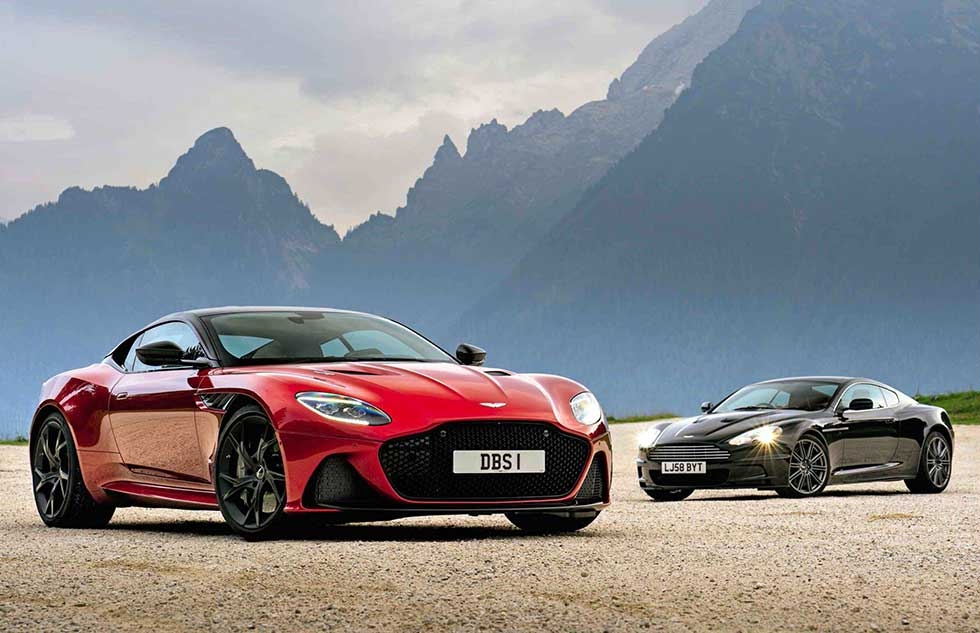
The ferocious new DBS Superleggera is Hyde to the DB11’s Jekyll. We compare it with its DBS predecessor. Words Richard Meaden. Photography Dean Smith.
DBS GENERATIONS WILD THINGS DBS SUPERLEGGERA TWIN TEST
Aston’s sensational new production flagship meets its DBS predecessor.
Monsters. Magnificent monsters with muscle, manners and irresistible magnetism. That’s what Aston Martins were all about when I was a lad. Back then it was the X-Pack Vantage that did Newport Pagnell’s bidding, facing down the Italian exotics and ruthlessly effective Teutons with classic British decorum, walnut veneer and a sodding great V8.
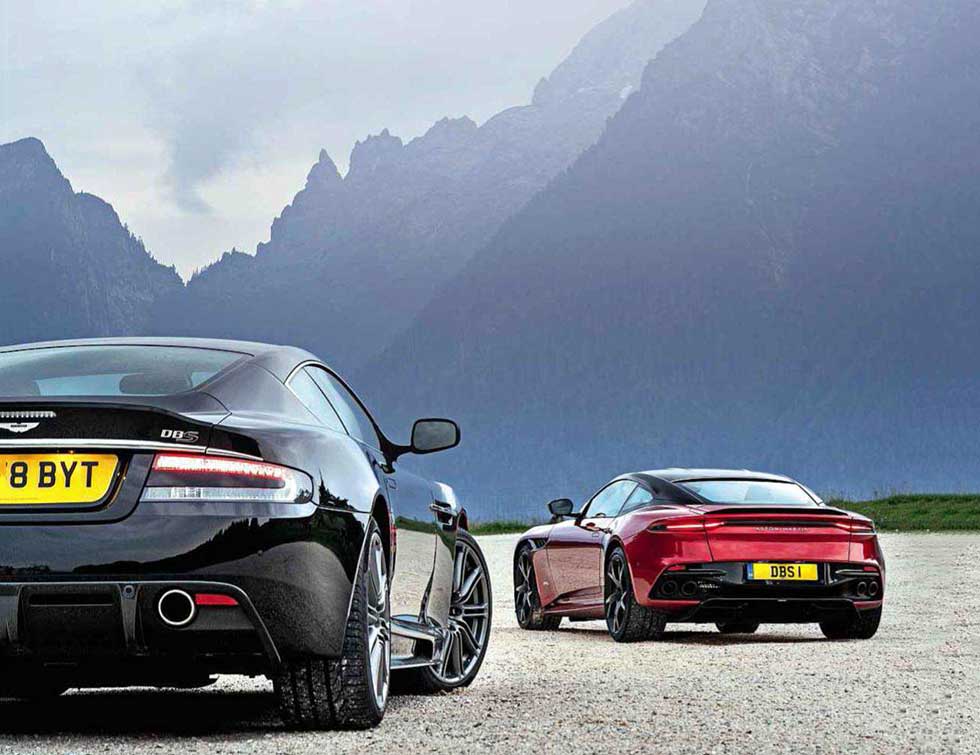
It was followed by the wide-bodied Virage 6.3 – a ferociously costly but undeniably effective hotchpotch of special order engine and chassis upgrades – and the twin-supercharged Vantage V550 and V600. That my formative years as a motoring journalist coincided with privileged access to the last of these formidable and unashamedly anachronistic brutes means a piece of my heart will always belong to these excessively potent hero cars.
‘The start-up is always a special moment in an Aston and the DBS doesn’t disappoint’
Though a big fan of both Vanquish generations, neither the Newport Pagnell original nor the subsequent Gaydon-built successor quite managed to project that bullish image, occupy the same space in the market or – bluntly – push the same primal buttons as those Big Beasts. They were too considered and too well within themselves to summon the same swashbuckling swagger, even though in truth they were much better cars.
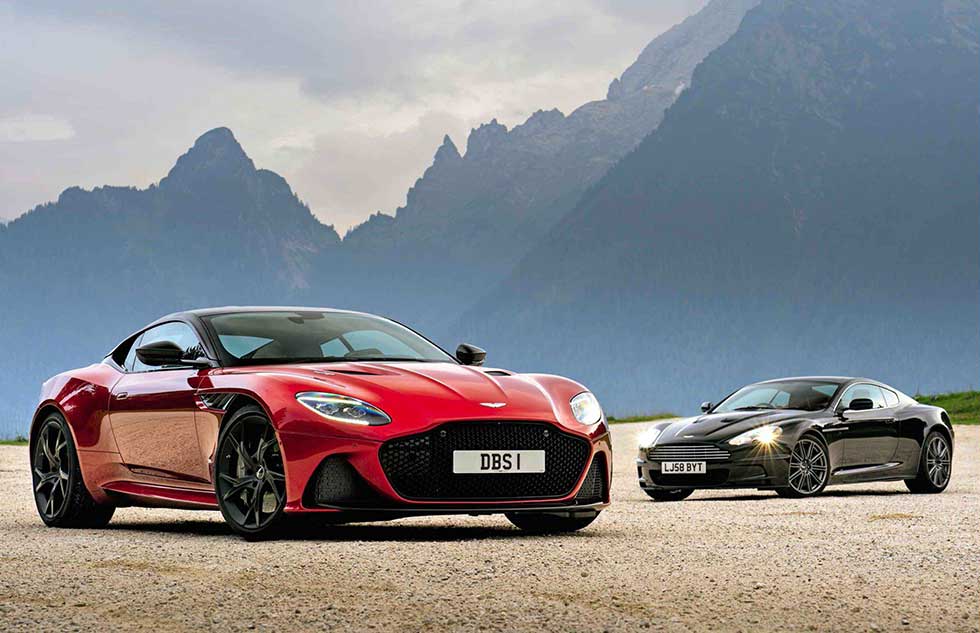
Taking all of the above into consideration, it will therefore come as no surprise to learn that the new DBS Superleggera should be my kind of Aston Martin. Just as with its forebears from my dim and distant youth, it promises to do things its own way.
And the car we’ve brought along to compare it with – the most recent car to wear the DBS badge – has more than a little of the bombast and belligerence of the old-school V8s, too. This was the wilder cousin to the DB9, with more power, more presence, and more attitude. The chance to drive them back-to-back is a mouthwatering prospect.
It’s been a while since I’ve spent time with the Gaydon-built DBS. Too long, truth be told. It’s a smaller, tighter proposition than the new bruiser, a muscled middleweight rather than a heavyweight prize-fighter. The vital stats back up this impression, the 5.9-litre naturally aspirated V12’s 510bhp and 420lb ft of torque, impressive in their day, now simply dwarfed by the DBS Superleggera’s 715bhp and 664lb ft.
If the pace of high-performance car development over the last decade has been startling, the appeal of a big-hearted sporting GT remains unchanged. Bound up in the romance – if not the modern reality – of long-distance travel, it’s something this old DBS still has in spades.
Inherently less try-hard than a mid-engined supercar, less blingy than a Bentley and more aristocratic than a Jaguar, the kudos bestowed by a V12 engine, immaculately sculpted body and the Aston Martin ‘wings’ badge still sets the Benz-era DBS apart from its contemporary rivals, and indeed its stablemates.
It’s hard now to look beyond the all-too-familiar head and tail lights, but when new the DBS flaunted its physicality more overtly than any previous Gaydon Aston. The broader shoulders, hips and sills gave it a gym-sculpted body not dissimilar to that of Daniel Craig’s Bond, who starred alongside the DBS in Casino Royale and Quantum of Solace and did rather a lot for sales of pale blue swimming shorts.
That star quality is still apparent when you approach the DBS V12, though it’s quaintly understated in the presence of the Marvel-spec Superleggera. The small, deep-set bonnet vents have something of the DBR9 racer about them, as does the chiselled front valance and prominent rear diffuser. It’s a busier-looking car than the DB9 or Vantage from the same era, but it has stood the test of time remarkably well.
It might not have carried the Superleggera badge, but Aston went to considerable effort to make the DBS lighter than the DB9, even going so far as using lighter semi-aniline leather for the upholstery and lighter material for the carpets. Most significant and successful of the weight- saving measures was the use of carbonfibre in place of aluminium for the bonnet, front wings, door surrounds, boot lid and boot enclosure. Together these contributed 30kg to an overall saving of some 65kg versus the DB9. The DBS V12 also featured carbon-ceramic brakes – another first for an Aston road car – and could be specified with carbonfibre sports seats for a further 20kg weight saving, though they were not available in North America.
The tuned V12 engine was initially mated to a six-speed close-ratio manual transmission, though this was joined by an optional Touchtronic 2 paddle-shift automatic gearbox in 2008. Our test car comes with the latter, which I’m pleased about for reasons of a like-for-like comparison with the auto-only Superleggera, but my pragmatism is tinged with sadness for I must say I have fonder memories of the stick-shift version. Though not, it must be said, for the clumsy, faceted aluminium gear knob, which as any Red Dwarf fan will tell you resembles Kryten’s head.
So paddles it is. Does it matter? Well, they do blunt the crisp immediacy I remember the manual DBS V12 being so adept at delivering.
But then this could also be because my senses are still scrambled by the new car’s lung-squeezing, head-spinning shove…
Part 2
You’ve doubtless read the initial first drives of Aston’s new production flagship, so I’ll skim through the nuts and bolts. Firstly let’s get the Superleggera bit out of the way. No, at just under 1.7 tons (without fluids), it isn’t a lightweight machine. In fact it’s anything but, although to be fair it is carrying less timber than the DB11 on which it is based, thanks to the use of alloys and composite materials in the body (more than 80 per cent) and structure. It’s this mixed-material construction that provides the historical hook from which to hang the hallowed Touring- owned name, and provides Miles Nurnberger’s design team with the perfect excuse to adorn the DBS’s beautiful bonnet with some of the “the automotive industry’s” coolest chrome-wrought typography.
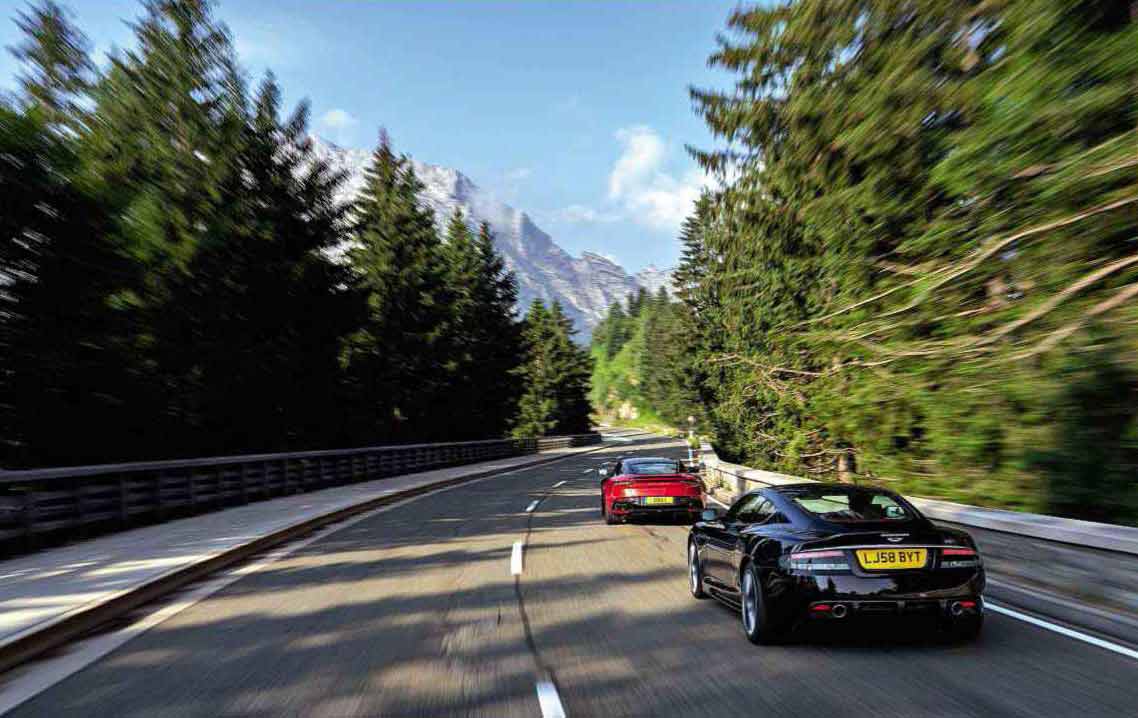
Apart from its compelling presence, what I love about the DBS Superleggera’s design is that it combines old-school purity of form with enormously effective aerodynamics. The way the airflow is channelled beneath, around, over and through the bodywork to harness its lift-reducing and stability- enhancing powers is deeply impressive.
Sharing structure, suspension, wheelbase and engine with the DB11 suggests obvious commonality, but although there’s a family resemblance, the DBS is very much its own car. That extends to the hardware, including a new, stronger eight- speed automatic transmission, carbon-ceramic brakes and the breathed-on V12, which actually just requires a calibration tweak to liberate the full 715bhp and 664lb ft. There’s a mechanical limited-slip differential and the usual suite of dynamic modes, plus detailed recalibration of the suspension, steering and powertrain to suit the DBS’s souped-up super-GT role.
There’s less differentiation in the cockpit, with much taken straight from the DB11. It’s a shame it’s not as different as the Vantage, but I guess there’s a limit to Aston’s budgets. And while I’m not a huge fan of the DB11/DBS interior aesthetic, it’s still made from fine materials and creates an impressive and, crucially, comfortable driving environment.
The start-up is always a special moment in an Aston and the DBS doesn’t disappoint. Turbocharging usually smothers some of the aural snap and crackle, but the Superleggera has a proper snarl that gently subsides into a menacing simmer at idle. You sit quite low, so you’re denied a view of some of the prolonged lines that rise from the nose towards the screen, but the way the elliptical door mirrors sit at the end of fine stalks to give you a view of the fat, One-77-like rear haunches is a nice reminder of what a special car you’re in.
Chassis? Pretty firm, to be honest. Even in GT mode it shoulders its way down the road with a slightly muscle- bound feel, but there is suppleness and it does settle once you get beyond urban speeds. The steering has some satisfying weight and just enough self-centring to feel the car wanting to pull straight, so there’s an appropriate level of connection and effort without it feeling contrived.
The front end responds calmly and with precision – good news, as you want to place this big car accurately and take a clean, smooth line. There’s a ton of grip, but it’s of the malleable sort so you can lean on it, slowly at first then with more insistence, to build a detailed picture of the chassis balance and what’s in reserve.
Long-eared shifters fixed to the steering column make it easy to pull for a gear, though in all honesty you don’t need much below fourth, such is the torque available from 2000rpm. You learn to squeeeeze the throttle and savour the ever-increasing sense of propulsion as the V12 gets on top of the gear. It’s a mighty sensation that only seems to emphasise the DBS’s effortless potency.
Stoke the fire a little and its personality hardens into something altogether fiercer. It’s not a screamer in the manner of a Ferrari 812 Superfast – the Aston’s turbocharged V12 is done and dusted by 7000rpm – but it has epic reserves of elastic performance that simply catapult you between the corners. This is the runaway-train sensation the X-Pack Vantage and V600 were so adept at delivering, the difference being that the DBS Superleggera has just as voracious an appetite for bends and braking.
It doesn’t feel as big as it looks, but on mountain roads such as those on the Austrian-German border there’s no denying it is a big car to hustle. You notice it in the relative lack of road you have to play with when cutting through a corner. In truth, while the hairpins are fun and the DBS is willing to be stood on its nose and then slung through on the throttle, it would be much more in its element on a road like the Route Napoleon where it could hit its stride and take the curves with a caress of the powerful, progressive brakes and a roll of the wrists.
That said, I can’t imagine anywhere I wouldn’t want to drive the DBS. Such are its powers of seduction and the sense of completeness and harmony in the way it goes about its business.
Part 3
Back in the earlier car, it takes a while to re-calibrate your brain to a different level of performance. The DBS V12 used to be a fierce creature, but in the wake of the new car it feels decidedly muted. The Touchtronic gearbox definitely doesn’t help in this regard, for it fosters a more relaxed approach. I’m sure a stick shift would spark things up a little, but it wouldn’t be transformational.
There’s a compact, straightforward feel about the older car, one enhanced by the lower waistline and the simplicity of its interior design. It’s an uncomplicated car that frees you from the need or temptation to toggle between dynamic modes. It’s an increasingly old-school approach, and one this DBS does well.
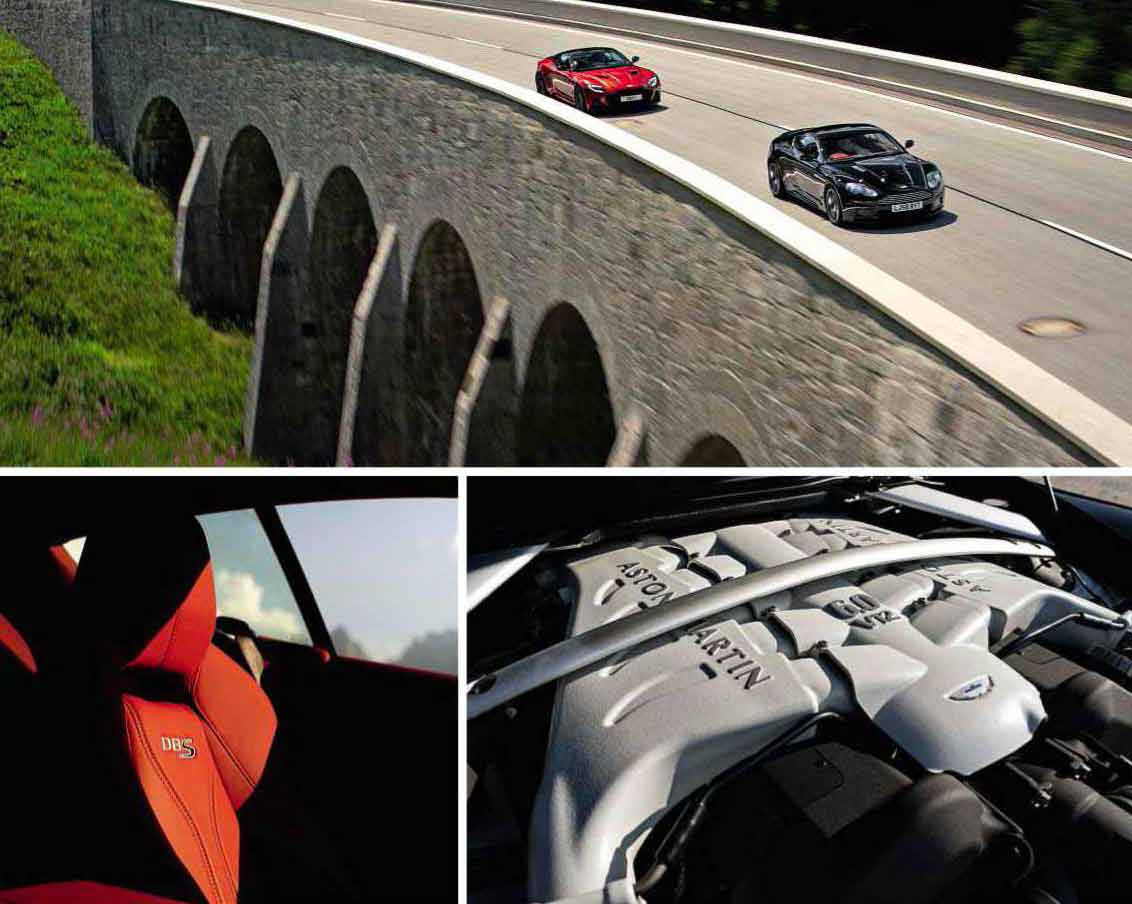
There are some similarities between the cars. They share a satisfyingly neutral balance, transparent handling limits and powerful, feelsome carbon-ceramic brakes. And, of course, there’s the dominant presence of a great V12. The 5.9-litre ‘AM11’ engine has always brought with it a sense of occasion and that’s certainly true here. Considering its generous capacity, there’s a surprising reliance on revs, even though the engine doesn’t run to unusually high rpms. It’s happiest hunting ground is between 4000 and 6500rpm: more and you know you’re revving for the sake of it; less and you crave a bit more torque. By normal standards it’s a fine engine, but the Superleggera’s motor is anything but normal.
The older car’s hydraulic power steering offers less assistance so feels nice and meaty, but it doesn’t have the brightness, clarity and nuanced feel of the Superleggera’s excellent electric power steering. It conveys a certain calmness in the older car, but it doesn’t have the younger Aston’s sense of energy pulsing through it.
Of course all things are relative, and compared with the DB9 the DBS offered an amplified driving experience, albeit one that didn’t push things on so far from that of a DB9 Sport Pack. If that sounds like faint praise, it’s not meant to, for there’s still something about the DBS V12 that stops you in your tracks. It’s a fine, fine car that successfully filled the role of flagship – and Bond car – at a time when Aston’s model range was more about incremental change than true individualism. I’d still love to own one – though it would have to be a manual – for much as I love the idea of an original V12 Vantage, this generation of DBS probably has a more legitimate claim on being Aston’s last analogue bruiser.
And what of today’s DBS? Well, it’s a real return to form. Where the DB11 has proved to be a slow-burner, improving as it evolves with V8 and AMR derivatives, and the new Vantage is finding that the much-loved previous model has left big shoes to fill, the DBS has stepped up to the plate with flawless self-assurance. Born to be the hero of the range, it carries the responsibility effortlessly on its ample shoulders and neatly sidesteps the baggage that would have come from being a direct replacement for Vanquish in name and deed.
When Andy Palmer set out his stall – and Aston Martin’s future – with his Second Century Plan, we were promised exceptional cars with distinctive designs that would feel as different as they looked. The DBS Superleggera is the best evidence yet of this coming to fruition.
If this family reunion tells us anything, it’s that the Bez-era DBS was too obviously related to the DB9, and therefore seemed poorly equipped to fill the void left by the charismatic mkl Vanquish. Conversely it also reminds us that if you can get beyond the headline figures and head-spinning performance of the Superleggera’s turbo motor, there’s a lot to be said for the nuanced delivery of a naturally aspirated V12. Especially when it’s powering a car that doesn’t fill the road quite so completely.
Ultimately the real success of the Palmer-era DBS is less to do with being quicker and more accomplished than the car it replaces (this much was always a given) and more to do with the fact it’s a big and ballsy character that stands comparison with any of Aston’s iconic range-topping behemoths of yore. That it does so without their manifold flaws – sorry, ‘character’ – makes the DBS Superleggera a very fine Aston indeed. That it takes the fight to its contemporary rivals from Ferrari and Bentley very much on its own terms makes this Aston Martin one of the finest sporting GTs money can buy. It’s been a while since we’ve been able to say that.
With thanks to Aston Martin Works for supplying the DBS V12.
‘The two share a satisfyingly neutral balance. and, of course, the dominant presence of a great V12’
Tech and photos
DBS Superleggera
ENGINE V12, 5204cc, twin-turbo
MAX POWER 715bhp @ 6500rpm
MAX TORQUE 664lb ft @ 1800-5000rpm
TRANSMISSION Eight-speed automatic with paddleshift, rear-wheel drive, limited-slip differential, torque-vectoring
SUSPENSION Front: double wishbones, coil springs, adaptive dampers, anti-roll bar. Rear: multi-link, coil springs, adaptive dampers, anti-roll bar
STEERING Rack-and-pinion, electrically assisted
BRAKES Vented discs, 400mm front, 360mm rear, ABS, EBD
WHEELS 9 x 21in front, 11 x 21in rear
TYRES 265/35 front, 305/30 rear, Pirelli P Zero
WEIGHT from 1693kg (dry)
POWER TO WEIGHT 429bhp/ton (dry)
0-62MPH 3.4sec (claimed)
TOP SPEED 211mph (claimed)
PRICE £225,000
Left and below You need plenty of road and open sight-lines, but the Superleggera does have a playful side. Turning up the wick on the twin-turbo V12 has unleashed the inner monster.
Opposite page Evolution of the Aston grille has taken a leap with the DBS Superleggera, as have the aerodynamics, though the new car retains classical GT proportions. Right and above Just as with the new car, the previous DBS was the production flagship in its day. Interior still special, as is that 5.9-litre naturally aspirated V12. Opposite and above The older car’s lines are ageing well, and its interior has an unforced elegance, but on the road the performance of the new car is on another level.
DBS (2007-2012)
ENGINE V12, 5935cc
MAX POWER 510bhp @ 6500rpm
MAX TORQUE 420lb ft @ 5750rpm
TRANSMISSION Six-speed manual (six-speed auto option from 2008), rear-wheel drive, limited-slip diff, traction control, stability control
SUSPENSION Front and rear: double wishbones, coil springs, adaptive dampers, anti-roll bar
STEERING Rack-and-pinion, power-assisted
BRAKES Vented carbon-ceramic discs, 398mm front, 360mm rear, ABS, EBD
WHEELS 8.5 x 20in front, 11 x 20in rear
TYRES 245/35 ZR20 front, 295/30 ZR20 rear, Pirelli P Zero
WEIGHT 1695kg
POWER TO WEIGHT 306bhp/ton
0-60MPH 4.2sec (claimed)
TOP SPEED 190mph (claimed)
PRICE NEW £160,000 (£220,000 in today’s money)






